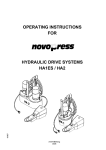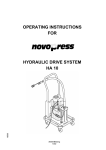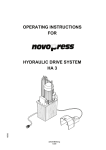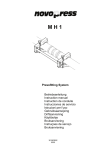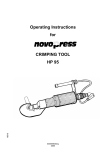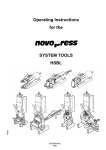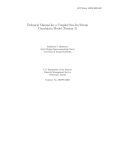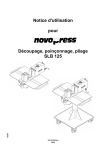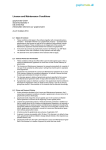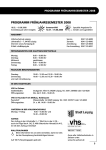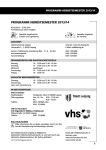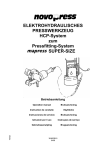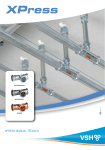Download OPERATING INSTRUCTIONS FOR HYDRAULIC
Transcript
OPERATING INSTRUCTIONS FOR 17452 HYDRAULIC DRIVE SYSTEM HA4 42780\B04eng 0409 Table of contents Page CE Conformity Declaration Safety regulations Technical data 1 Range of application 2 Construction 2 Connecting system tools 3 Three-phase safety pedal switch 4 Operation 5 Maintenance 6 Appendix: - Circuit diagram - Hydraulics diagram 42780\B04eng 0409 GENERAL SAFETY REGULATIONS Read all safety regulations and instructions! 1. Keep the place of work clean. Disorderly work-places and work-benches invite accidents. Ensure that lighting is good. 2. Keep children away. Do not allow unauthorised persons to touch the device or the cable. Keep unauthorised persons away from your place of work. 3. Wear suitable working clothing. Do not wear any wide clothes nor jewellery - they may get caught up in moving parts. When working in the open it is recommended that you wear rubber gloves and non-slip footwear. Wear a hair- net if you have long hair. 4. Always be alert. Only use a device after having been instructed in its operation. Concentrate on your work. Proceed sensibly. Do not use the device when you are distracted. 5. Do not lean too far forward. Avoid abnormal stance. Make sure that you have a secure standing position, and maintain balance at all times. 6. Leave safety devices where they belong. 7. Hand tools may not be installed as fixtures. 8. Repair and maintenance. Have repairs and maintenance work carried out in an authorised NOVOPRESS specialist workshop. Only use original and identical NOVOPRESS spare parts. We reject all responsibility and liability for work carried out by third- party personnel. 009NP004.DOC SAFETY INSTRUCTIONS FOR HYDRAULIC EQUIPMENT 1. Please read the operating instructions. Acquaint yourself with the hydraulic equipment. 2. Provide the equipment with the necessary care. Always keep the equipment in operational condition. Cleanness is an essential requirement for good and safe working. 3. Switch off the electric power supply to the hydraulic equipment, • when the equipment is not in use • when maintenance work is to be carried out. 4. Avoid unintentional switching - on. Keep hands and feet away from the switch when the equipment is not being used. 5. Do not use the equipment in a manner in contravention of the instructions. Never carry the equipment by the pipe or pull on the pipe. Protect the piping from heat, oil, sharp edges and high levels of weight strain. 6. Use only piping, fittings and accessories wich have been designed for the operating pressure of the hydraulic unit. BURSTING PRESSURE OR TEST PRESSURE IS NOT OPERATING PRESSURE! Avoid squashing or bending of the piping. Piping must not be painted over. 7. Replace the hydraulic piping • when cracks, squashed or bent points are to be seen • when blistering is established • when hydraulic fluid escapes • when pipe fittings are damaged • when discolouration is established on the outer layer, e.g. due to the influence of solvents. 8. The hydraulic fluid used in the system is kerosene-based. This requires particular care and attention. • Avoid continuous contact with the skin • ensure that the hydraulic fluid does not get into the eyes or mouth. Hydraulic pipes have to be replaced after 5 years of usage, despite of the circumstance that no damages should be remarkable. 9. The equipment must not be operated, if it has leaks and there is a danger of hydraulic fluid coming into contact with persons, open fire, heating equipment, electric cabling, ground water, foods and other substances which are intended for human consumption. 10. Hydraulic units with petrol engines • must not be operated in closed rooms, due to the DANGER OF INTOXICATION! • do not pour in petrol while the motor is running or in the vicinity of open fire. DANGER OF EXPLOSION! 009NP006.DOC SAFETY TIPS FOR ELECTRIC TOOLS ATTENTION: In order to avoid electric shock, danger of injury and burning the following basic safety measures are always to be taken when using electric tools. Read and observe the notes before using the device. Keep the safety tips in a safe place. 1. Take influences of the surroundings into account. Do not expose electric devices to rain. Do not use electric devices in damp or wet surroundings. Do not use electric devices in the vicinity of flammable liquids or gases. 2. Protect yourself from electric shock. Do not fix additional rating plates or symbols with rivets or screws. Use adhesive signs. When working with electric devices avoid body contact with earthed objects such as pipes, heating appliances, refrigerators etc. 3. Use the correct tools. Only use the tools and accessories outlined in the operating instructions. Do not use the electric device to do work for which it is not intended. 4. Secure the work piece. Use gripping devices or vice grips to hold the work piece steady. It is more securely held than by hand and you can operate the device with two hands. 5. Do not overload your electric device. You can work better and more securely in the indicated power range. 6. Do not use the cable for purposes for which it is not intended. Do not carry the electric device by the cable. Do not use the cable in order to pull the plug out of the socket. Protect the cable from heat, oil, acids and sharp edges. For working in wet rooms or in the open only use the authorised extension cables with the corresponding marking. 7. Avoid unintentional starting. Ensure that the electric device is switched off before connecting the mains plug. Do not carry the electric device in such a way as that your finger is on the switch. Do not use the electric device if the ON/OFF switch does not work perfectly. 8. Disconnect the mains plug: • if the device is not in use • before maintenance of the electric device • when changing tools 9. Carefully maintain the electric device. The best and most secure work is guaranteed if you: • keep the electric device clean • observe the instructions for greasing, changing the tools and ancillary equipment • regularly check the connection cable and the extension cable • have damaged cables repaired by a specialist • keep hand grips dry, clean and free form oil and fat • have the electric device examined and cleaned by a specialist after 900 operating hours. 009NP005.DOC 10. Keep electric devices in a safe place. Store electric tools and accessories out of the reach of children, in dry, high-lying places or in locked rooms. 11. Electric devices are often used by more than one person. Therefore before beginning to work you should check: • the socket to ensure it is securely fixed and is not damaged in such a way as can be seen from the outside • the connection cable for outward damage to the insulation and for sharp kinks • that the cable is securely fixed to the device and whether the insulating plastic tube is damaged • that the switch is secure and shows no outward signs of damage • whether protective appliances or damaged parts function properly • whether movable parts jam or are damaged • do not use the device in the event of finding defects • only allow the device to be repaired by a specialist or in an authorised NOVOPRESS specialist work-shop • only use original and identical NOVOPRESS spare parts. 009NP005.DOC 1 Technical data Electric motor: Supply voltage: Frequency: Frequency RPM Power consumption see rating plate see rating plate 50 Hz 2800 min –1 1,5 kW Mode of operation: Protection class: Mode of protection: 60 Hz 3380 min –1 1,5 kW S1 I IP - 44 Hydraulics: Pump: Frequency Delivery rate 50 Hz 9 l/min 60 Hz 9 l/min Hydraulic connection: Quick-action coupling plug with back-pressure valve Operating pressure: 150 bars max. Dimensions: H = 560 mm; Weight incl. oil: 45 kg Hydraulic oil: Oil filled in at works: ISO VG 32 DIN 51519 B = 420 mm; L = 470 mm Oil usable: Oil in viscosity class: ISO VG DIN 51519 from 32 to 46 42780\B04eng 0409 2 Range of application The NOVOPRESS hydraulic control unit operate in the low-pressure range up to 150 bars, and it is used as drive unit for our hydraulic system tools. Function The motor is switched on via the main switch (1). The motor runs in idle. Pressure is built up by actuating and holding the pedal switch. The piston of the connected system tool is advanced. The system tool "works". Releasing the pedal switch retracts the system tool. The hydraulic unit is ready for the next operation. Following completion of work or, at the latest, at the end of the working day, switch off the motor by setting the main switch (1) to OFF. Construction An oil-filling screw with breather valve (3) and an oil gauge (4) are mounted on the oil tank cover. Oil gauge (4): The gauge stick of the oil gauge must be between the two markings. If the gauge stick is at the lowest marking, oil needs to be added. Bleeding valve (3): The air-relief valve closes if the tank is on the slant (no oil can emerge). In the vertical position (operating position), a slight amount of oil vapour may be carried over with the escaping air. The oil film which this causes on hydraulic equipment should be removed from time to time. Note: The equipment must not be switched on while horizontal. There is a risk that the pump will not draw in oil and is damaged as a result. 42780\B04eng 0409 3 Connecting system tools The system tools are connected to the hydraulic control unit by means of the hydraulic hose (2), using the quick-action coupling. Connecting the hydraulic line Quick-action coupling Coupling-up Hold the coupling socket (KM) up to the sliding sleeve (SH), and slide it onto the coupling plug (KS). Uncoupling Hold the coupling socket (KM) at the sliding sleeve (SH) and pull it of the coupling plug (KS). Note: - When changing the system tools, a small amount of oil will remain between the back-pressure valves of the coupling. - Handle the hydraulic hose with care. Bends at the connection points will lead to premature breakdown. When coupling up, make sure that dirt does not penetrates the coupling. - Before coupling up another system tool, wipe out the coupling socket with a clean cloth that is free of fluff. - The system tools should, as far as possible, remain coupled up at all times. Connecting electrical leads 1. Connect the mains cable to the power suply line. Note: Observe the mains voltage (see identification plate)! 2. Rotation of the drive must correspond with the marking/label on the drive cover. Please check and ensure correct rotation as under. 3. Unplug mains. Remark! Do not detach the mains plug. 4. Inside the mains plug, two contact pins are revolving. Use a screwdriver in slot X and rotate pins 180 degree. 5. Plug in mains. 6. Check correct rotation. If rotation is correct, connected hydraulic equipment (e.g. HSBL- Work Cylinder) must move out. 42780\B04eng 0409 4 Three-phase safety pedal switch 1. 2. 3. 1. Pedal not actuated System tool "OFF" 2. Pedal actuated as far as detectable stop of pressure point System tool "ON" 3. Pedal actuated beyond pressure point "EMERGENCY STOP" Pedal switch locked. Note! When EMERGENCY STOP is actuated: -The hydraulic pressure is switched off and cannot be restarted by pressing the pedal again. -To release the EMERGENCY STOP, press the blue pushbutton (6). -(If the main switch is set to ON, hydraulic pressure is available again.) 42780\B04eng 0409 5 Operation Note! - The equipment must not be switched on while horizontal. There is a risk that the pump will not draw in oil and is damagedas a result. • Set the main switch to ON • Actuate the pedal switch, and hold it down. Note! When pedal switch is released, the piston of the system tool will return immediately. • The piston of the conected system tool will travel forwards. The system tool is "working". • Once the work process has been completed or the safety valve has responded, release the pedal switch immediately. Otherwise the oil will heat up unnecessarily. Note! - Care should be taken to ensure that the oil temperature does not exceed 70 °C during operation. - Pressure can only be built up again once the key has been released and actuated again. • Following completion of work or, at the latest, at the end of the working day, set the main switch to OFF. 42780\B04eng 0409 6 • Maintenance We recommend that our authorized NOVOPRESS specialist workshops be used for repair and maintenance work. Only have the equipment maintained by a specialist. Caution! BEFORE ANY MAINTENANCE OR REPAIR WORK, ALWAYS PULL OUT THE MAINS PLUG! Check oil level The gauge stick of the oil level indicator (4) must be between the two markings. If it is at the lowest marking, oil must be added. Top up the oil if necessary. Oil change First oil change: Other oil changes: After about 1,000 starts, or after 3 months After every 15,000 starts, but at least once annually Oil volume for: 12 litres Hydraulic oil: See Technical Data Oil filter: The oil filter is the suction strainer with a mesh width of 0.06 mm. • Unscrew the oil filling screw with the air-relief valve (3) on the oil tank cover. • Draw off the old oil by means of suction. • Fill with new oil. Note! The gauge stick of the oil level oil gauge (4) must be between the two markings. Cleaning: Remove the oil film from the hydraulic unit every month. Hydraulic hose: The hydraulic hose is to be checked for damage every month. Replace hydraulic hose: - If any cracks, crush points, or kinks are visible on the outer layer - If blister formation is visible - If pressurised fluid is escaping - If the hose armature is damaged - If any discolouration of the outer layer is visible, e.g. due to the effect of solvents. Hydraulic hoses must be replaced after 5 years, even if no damage is visible. 42780\B04eng 0409 7 Visual and electrical inspection Regularly: Check mains cable including plug and extension cord with plug connectors for visible damage and have repaired, if necessary. Every 6 months: Check in accordance with DIN VDE 0701-1 and DIN VDE 0702-1 for electric devices of the protection class 1 carried out by a qualified technician, an authorized workshop or Novopress Neuss. Hydraulic drive unit H A 4 Legend: 1 = Main switch 2 = Hydraulic hose 3 = Air-relief valve 4 = Oil gauge 6 = Pushbutton 7 = Pedal switch 42780\B04eng 0409 Repairs / Service Scharnhorststraße 1 D-41460 Neuss PO Box 101163 D-41411 Neuss Tel. 02131 / 2880 Telefax 02131 / 28855
















